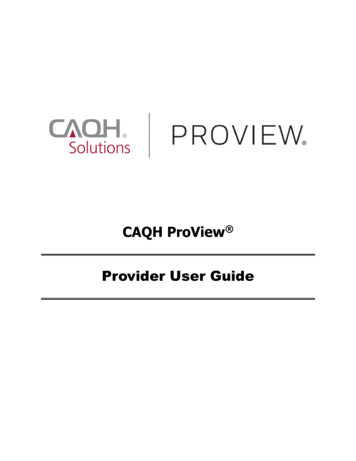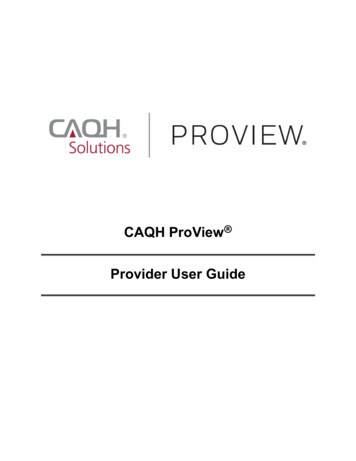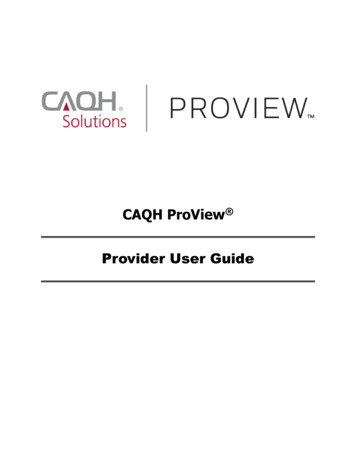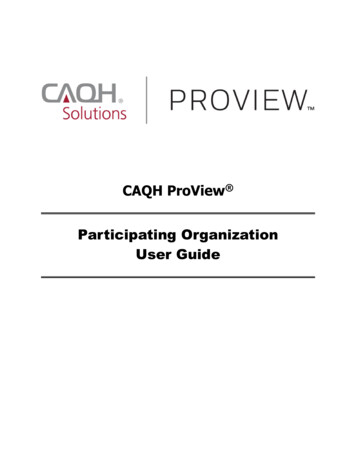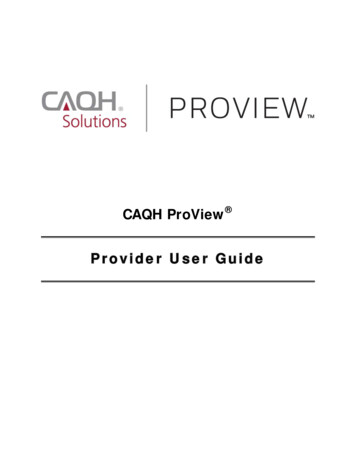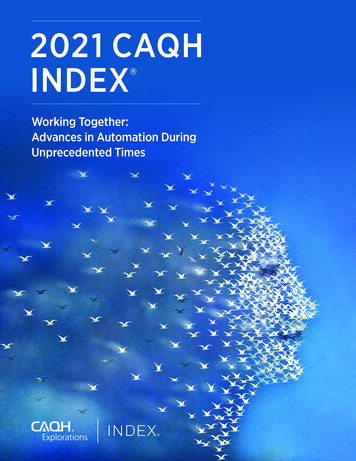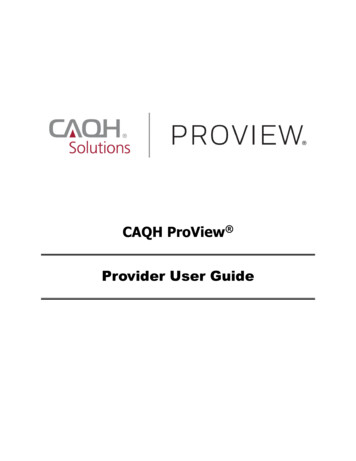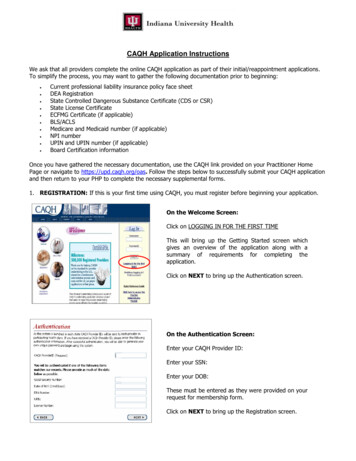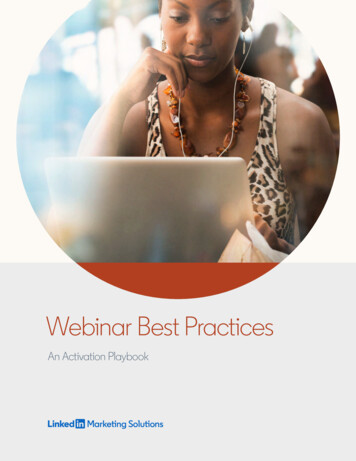
Transcription
CAQH CORE National WebinarStreamlining Collections and Reducing CostsUsing CAQH CORE 360 Rule:A Provider’s ExperienceJanuary 22, 20152:00 – 3:00pm ET
Participating in Today’s Session Download a copy of today’s presentation onthe CAQH.org website The phones will be muted upon entry andduring the presentation portion of the session At any time throughout the session, you maycommunicate a question via the web –Submit your questions on-line at any time byentering them into the Q&A panel on the righthand side of the GoToWebinar desktop–On-line questions will be addressed firstThere will be an opportunity today to submitquestions using the telephone–2Navigate to the CORE Education Events pageand access a pdf version of today’s presentationunder the list for today’s eventWhen directed by the moderator, press the“raise hand” button to join the queue for audioquestions 2015 CAQH. All rights reserved.
Session Topics3 Welcome Introduction CAQH CORE 360 Rule: Uniform Use of CARCs and RARCs Overview Maintenance Process CORE 360 Rule Implementation Perspective – Emory Healthcare Audience Q&A 2015 CAQH. All rights reserved.
CAQH CORE 360 RuleUniform Use of CARCs andRARCsOverview and Maintenance Process4 2015 CAQH. All rights reserved. 2014 CAQH. All rights reserved.
CAQH COREin Process ofdraftingrulesHHS NPRM anddeadlineadjustmentissued 12/31/13Mandated Requirementsavailable and should bein use in marketACA Mandated Operating Rules and CertificationCompliance Dates Reminder5ComplianceCompliance inEffectEffect asas ofJanuary 1,1, 20132013JanuaryCompliance inComplianceEffect asas ofEffectJanuary 1,1, 20142014JanuaryProposesProposes D 2015Implement byImplement byJanuary 1,January 1, 20162016(Draft Rulesavailable in(Draft Rulesavailable inEarly 2015)Late 2014) Eligibility for health plan Claim status transactionsHIPAA covered entities conduct these transactionsusing the CAQH CORE Operating Rules Electronic funds transfer (EFT) Health care payment and remittance advice (ERA)HIPAA covered entities conduct these transactionsusing the CAQH CORE Operating RulesProposes health plans certify via either COREcertification or HIPAA Credential; applies to Eligibility/Claim Status/EFT/ERA operating rules and underlyingstandardsApplies only to health plans and includes potential penalties for incomplete certification;existing voluntary CORE Certification is for vendors/PMS/large providers, and health plans Health claims or equivalent encounter informationEnrollment/disenrollment in a health planHealth plan premium paymentsReferral, certification and authorizationHealth claims attachments (HHS Standard not yetmandated) 2015 CAQH. All rights reserved.
CAQH CORE Uniform Use of CARCs and RARCs RuleFour Business istent Use ofTens of Thousandsof Potential CodeCombinationsFour Common Business ScenariosPost CORERulesCORE BusinessScenario #1:AdditionalInformationRequired –Missing/Invalid/IncompleteDocumentation( 380 code combos)CORE BusinessScenario #2:AdditionalInformationRequired –Missing/Invalid/Incomplete Datafrom SubmittedClaimCORE BusinessScenario #3:Billed Service NotCovered by HealthPlan( 650 code combos)( 347 code combos)Code Combinations not included in the CORE-defined BusinessScenarios may be used with other non-CORE Business Scenarios6 2015 CAQH. All rights reserved.CORE BusinessScenario #4:Benefit for BilledService NotSeparately Payable( 60 code combos)
CAQH CORE Code Combinations Maintenance ProcessCORE BusinessScenario #1:Additional InformationRequired –Missing/Invalid/IncompleteDocumentation( 380 code combos)CORE BusinessScenario #2:Additional InformationRequired –Missing/Invalid/Incomplete Data fromSubmitted Claim( 347 code combos)CORE BusinessScenario #3:Billed Service NotCovered by HealthPlan( 650 code combos)CORE BusinessScenario #4:Benefit for BilledService Not SeparatelyPayable( 60 code combos)CAQH CORE Compliance-based ReviewsStability of CORECode Combinationsmaintained Occur 3x per year Triggered by tri-annual updates to the published CARC/RARC lists by codeauthors Include only adjustments to code combinations to align with the published code listupdates (e.g. additions, modifications, deactivations)CAQH CORE Market-based ReviewsSupports ongoingimprovement of theCORE CodeCombinations7 Occur 1x per year Considers industry submissions for adjustments to the CORE Code Combinationsbased on business needs (addition/removal of code combinations and potential newBusiness Scenarios) Opportunity to refine the CORE Code Combinations as necessary to ensure the CORECode Combinations reflect industry usage and evolving business needs 2015 CAQH. All rights reserved.
Maintenance: Uniform Use of CARCs and RARCs RuleCORE Code Combinations Task Group (CCTG) Goal: Ongoing, data-driven focus on bringing uniformity to claim adjustment code See dedicated webpage Composed of more than 40 CORE Participating Organizations from a wide variety ofstakeholders; led by four multi-stakeholder Co-Chairs:– Shannon Baber, UW Medicine– David DuBay, UnitedHealth Group– Heather Morgan, Aetna– Janice Cunningham, RelayHealth Conducts three Compliance-based Reviews (CBR) and one Market-based Review(MBR) per year– Compliance-based Review Work: Met deadlines on Completion of all three Compliance-based Reviews Task Group currently conducting CBR in response to code adjustments published on November1, 2014, with February 1, 2015 deadline– Market-based Review Work:8 Completed updates to First Annual 2013 Market-based Review in July 2014 Launched 2014 MBR on November 26, 2014; survey incorporates process improvements andlessons learned from the 2013 MBR 2015 CAQH. All rights reserved.
2014 Market-based Review ProcessOverview Basic Information– 60-day Submission Period; launched on 11/26/2014 and all adjustmentrecommendations must be submitted to CAQH CORE via the online MBR Formby 5pm ET on Monday, 1/26/2015– All submissions must be made via the online Market Based Review submissionform (MBR Form) Adjustments must be requested using the latest version of the CORE CodeCombinations Scope of the 2014 MBR: Code Combinations Adjustments – includes codeadditions/removals/relocations for existing CORE-defined BusinessScenarios Potential new CORE-defined Business Scenarios – Includes formal callfor potential additions of new CORE-defined Business Scenarios 9In addition to New Business Scenarios, submitters must identify CodeCombinations to associate with these requested new CORE-defined BusinessScenarios 2015 CAQH. All rights reserved.
2014 Market-based ReviewCall to ActionOnlytoGet your 2014 MBR Submissions In!In order for your organization to receive the full benefits of the CORE 360 Rule, it isbeneficial for you to take part in the CORE Code Combination Maintenance Process.Submitting adjustments via the 2014 Market-based Review Submission Form ensures thatthe CORE Code Combinations and Business Scenarios: Reflect your specific business cases/needs Are thorough, precise and accurate Address the problem space in the most effective way2014 MBR Training SessionCAQH CORE held a training session on theonline MBR Submission Form in December2014. You can access the Slide Deck andRecording of that training session on ourEducation Events Page.10Dedicated CORE 360 RuleWebpageFor more information please visit CAQHCORE’s dedicated webpage for CAQH CORE360 Rule and the Code CombinationsMaintenance ProcessAdditional resources for the 2014 Market-based Reviewcan be found in the appendix of this presentation 2015 CAQH. All rights reserved.
CAQH CORE Operating Rule Maintenance2015 TimelineQ1Q2Q3CBRMBR Release of Updated CARC & RARC Lists by Code Committees (triggers CBR) CORE Compliance Based Review of updated CARC and RARC lists Release of Updated CORE Code Combinations List 2014 Market-based Review Submission Period (Closes January 26th) Expected Release of CORE Code Combination Updates based on 2014 MBR Expected Release of New Business Scenario Updates based on 2014 MBR11 2015 CAQH. All rights reserved.Q4
emoryhealthcare.org12
Streamlining Collections & Reducing CostsUsing The CAQH CORE 360 Rule:A Provider's Experience – Emory HealthcareJanuary 22nd, 2015By Adam Gobin, Ashely Rosiek & Adam Townsendemoryhealthcare.org13
PRESENTER BIOGRAPHIES:Adam Gobin – The Emory Clinic Assistant Director, Patient Financial Services/Accounts Receivables Email: adam.gobin@emoryhealthcare.orgAshley Rosiek – The Emory Clinic Operations Analyst, Department of Accounts Receivables Email: ashley.carville@emoryhealthcare.orgAdam Townsend – The Emory Clinic Operations Analyst, Department of Accounts Receivables Email: rg14
Table of Contents: Emory Healthcare & The Emory Clinic the largest & most comprehensive healthcare system in Georgia. The PROBLEM & ANSWER Statements review of the ACA & CAQH CORE standardization implications. Denial Centralization a whole new way of thinking (CARCs, RARCs, Management Engineering, & BIG DATA)! Lessons Learned & Best Practices the future of healthcare is NOW! Questions?emoryhealthcare.org15
ORGANIZATIONAL BACKGROUND:EMORY HEALTHCARE ENTITIESEmory University Hospital Founded in 1905 579-bed adult, tertiary care facility Staffed by 1,100 Emory SOM Faculty 24,000 admissions 78,000 outpatient servicesEmory John’s Creek Hospital Founded in 2007 Acquired in 2011 by Emory 110-bed acute care facility 10,000 admissions 50,000 outpatient servicesEmory University Hospital Midtown Founded in 1908 511-bed adult, tertiary care facility Staffed by 950 Emory SOM Faculty and 540community physicians 23,000 admissions 165,000 outpatient servicesEmory St. Joseph’s Hospital Founded in 1880 Joint operating company with Emory in 2011 410-bed acute care facility Staffed by 750 physicians 20,000 admissionsEmory University Orthopedics and SpineHospital Founded in 2007 120-bed adult, Orthopedics and Spine specialtyhospital Extension of EUH’s acute care servicesThe Emory Clinic Founded in 1953 1,500 clinical providers 3,000,000 patient care visits 125 locationsWesley Woods Center Founded in 1954 100-bed geriatric specialty facility 25-bed inpatient hospice service 250-bed skilled nursing facility (Budd Terrace) 201-unit residential retirement facility (WesleyWoods Towers)Emory Specialty Associates Established in 2006 300 clinical providers 450,000 patient care visits 38clinical locationsSlide 16
THE PROBLEM STATEMENT: There exists a gap between payers & providers – particularlydealing with language of patient billing information.“According to projections from the Centers for Medicare & Medicaid Services (CMS), denials could increaseanywhere from 100-200 percent, and days in accounts receivable (A/R) could grow by as much as 20-40 percent.”- American Academy of Professional Coders (AAPC), May 2014emoryhealthcare.org17
THE ANSWER: ACA & CAQH CORE Phase I - Phase I CORE Rules focused on improving electronic eligibility and benefits verification,as eligibility is the first transaction in the claims process. Phase II - Phase II CORE should be extended to include rules around the claim status transactionto allow providers to check the status of a claim electronically, without manual intervention, orconfirm receipt of claims. Phase III - CORE 350 Health Care Claim Payment/Advice (835) Infrastructure Rule.emoryhealthcare.org18
CAQH CORE CATEGORIZATION: Business Scenarios:–Scenario #1: Additional Information Required-Missing/Invalid/Incomplete Documentation.–Scenario #2: Additional Information Required-Missing/Invalid/Incomplete Data from Submitted Claim.–Scenario #3: Billed Service Not Covered by Health Plan.–Scenario #4: Benefit for Billed Service Not Separately Payable.Sparking an innovative idea using a categorization/classification of denials to drive workflow!Categorizing CARCs & RARCs by groups using CORE Code Combinations – increasesefficiency of denial follow up and cash turnaround!emoryhealthcare.org19
WELCOME TO AR 2.0:DENIAL CENTRALIZATION!Denial Centralization: An asserted effort by The Emory Clinic to centralize andstandardize the AR workflow of denial management, discover root causesacross all denial groups, & engage major stakeholders (vendors, payers orproviders) to increase efficiency.THE IDEA Payers & Providers work together for mutual benefits!Define Denial Codes and Remark Codes.Measure through daily and weekly pulse reports.Analyze through concise project charter.Improve through standard operating procedures.Control through quality audits and monitoring “Days to Pay”.emoryhealthcare.org20
emoryhealthcare.org21
MANAGEMENT ENGINEERING TECHNIQUES:Part IUsed CAQH/CORE DataVerified OutcomesPhone Calls to thepayers!Claims inquiries viaweb portals!Proper DenialCategorizationemoryhealthcare.org22Reject CodeReject ReasonCategoryM127Missing patientmedical record.MedicalDocumentation
Part IIBIG DATA: CONSTRUCTIVE & ACTIONABLE ANALYTICSThe process of examining big data to uncover hidden patterns, unknowncorrelationsother useful information that can be used to make betterData andAnalyticsdecisions.Utilize both claims and remit data to createpredictive and prescriptive models.Emory Clinic’s Data Analytics Case Study: Administrative Denial ManagementAppealsToolChargeBig data is now a reality: The volume, varietyand velocity of data comingandinto your organization continueslevels.Data to reach 3AnalysisClaimsData
CASE STUDIES:UNDERSTANDING & DEVELOPING A COMMON LANGUAGE Payer #1 252 Denials – TEC scheduled weekly calls with Payer #1 to inquirefurther into 252 root cause denial.PAYOR CASE STUDY DENIAL CODE & COMBINATIONCENTRALIZED DENIAL GROUP252COORDINATION OF BENEFITS252 MA04COORDINATION OF BENEFITS252 N29MEDICAL DOCUMENTATION252 N102MEDICAL DOCUMENTATION252 N463MEDICAL DOCUMENTATION252 N202MEDICAL DOCUMENTATION252 M127MEDICAL DOCUMENTATIONInvoice CountInvoice BalanceOCTOBER215 414,522.59NOVEMBER212 462,446.45DECEMBER304 296,126.62Grand Total731 1,173,095.66Payer #2 Fax Back– TEC worked with Payor #2 to gain access to a futuristicfax-back communication device, allowing access to payer raw remit data.emoryhealthcare.org24Month
BENEFITS OF CORE 360 RULE: Consistent and uniform use of CARCs, RARCs, CAGCs and NCPDP RejectCodes for electronic reporting of claims adjustment and denials has helpedto mitigate:––––– Unnecessary manual provider follow-upFaulty electronic secondary billingInappropriate write-offs of billable chargesIncorrect billing of patients for co-pays and deductiblesPosting delaysImproving Organizational Efficiency & Sustainability:– Denial grouping and accurate routing for proficient denial management Repetition breeds hyper-specialization– Increase organizational efficiency Less staff time spent on phone calls and websitesIncreased ability to conduct targeted follow-up with health plans and/or patientsMore accurate and efficient payment of claimsemoryhealthcare.org25
LESSONS LEARNED: CORE Code Combinations the Denial Centralization concept is born!–Improving denial management through data analytics and management engineering techniques.–Working together to build a foundation for the future!–1st attempt for payors & providers working together for mutual benefit (decreasing overall administrative costs)!General Implementation Considerations & Challenges:–Planning and Resources reject code & type dictionaries.–Implementation Considerations/Steps identifying centralized denial groups, creating centralized denial teams &members, SOP’s & reporting (stage summary, days to pay, etc.)–Challenges & Resolution – stakeholder buy in, setting up systematic accountability, generalists v. specialists,equivalent reporting.emoryhealthcare.org26
KEY TAKEAWAYS! The Emory Clinic has begun a relationship with CAQH – utilizing COREcode combinations to effectively redefine & centralize denial groups on arecurring basis. The Emory Clinic continues ongoing collaborations with payors,clearinghouses, & banks to streamline workflows. Breeding consistency, transparency, & accountability - denial centralizationhas successfully reduced The Emory Clinic’s AR metrics:––––––7-Day Decrease in Total DAR!25.6% Decrease in Registration/Insurance Related Denials!32.15% Decrease in Medical Documentation Denials!30% Increase in 180 Day Payments!45.22% Decrease in Monthly Write Offs!Predictive v. Reactive Analytics!emoryhealthcare.org27
emoryhealthcare.org28
QUESTIONS?“Every system is perfectly designed to achieve exactly the results it gets.”- Dr. Paul Batalden, Co-Founder of IHIemoryhealthcare.org29
Q&APlease submit your question: Via the Web: Enter your question intothe Q&A pane in the lower right handcorner of your screen30 2015 CAQH. All rights reserved.
Q&APlease submit your question: By Phone or VoIP: When prompted foraudio portion of Q&A, please press“Raise Hand” Button to queue up to aska question31NOTE: In order to ask a question during the audioportion of the Q&A please make sure that you haveentered the “Audio PIN” (which is clearly identified onyour user interface) by using your telephone keypad. 2015 CAQH. All rights reserved.
Thank You for Joining Us!website: www.CAQH.orgemail: CORE@caqh.org@CAQH32 2015 CAQH. All rights reserved.
YouIf You33 2015 CAQH. All rights reserved. 2014 CAQH. All rights reserved.
APPENDIXAdditional Information and Resources34 2015 CAQH. All rights reserved.
Implementation Steps for HIPAA Covered EntitiesFree Tools and ResourcesCAQH CORE has a NEW Implementation Resources webpage which contains descriptions ofand links to all available free tools and resources including those outlined below and many others!Education is keyGet executive buy-in early––––Read the CAQH CORE OperatingRulesListen to archive of past CAQH COREEducation Sessions or register toattend a future oneSearch the EFT & ERA FAQs forclarification on common questionsUse our Request Process to Contacttechnical experts throughoutimplementationDetermine Scope of Project–35The Analysis and Planning Guideprovides guidance to completesystems analysis and planning forimplementation. Information attainedfrom the use of this guide informs theimpact of implementation, theresources necessary forimplementation, as well as, what wouldbe considered an efficient approach to,and timeline for, successfulimplementation.Just GettingStartedEngage Trading Partners Earlyand Often–Provider’s: Use the EFT/ERASample Health Plan and SampleFinancial Institution Letters as away to help facilitate the request toreceive EFT from your health plansand the request for delivery of thenecessary reassociation dataelements from your financialinstitutionsAnalysis andPlanningSystemsDesignSystemsImplementationTEST, TEST, TEST!–Leverage Voluntary CORECertification as a quality check, a wayto test with partners, and as a way ofcommunicating compliance to theindustry and other trading partnersIntegration &TestingGet Involved with CAQH CORE–Deployment/Maintenance 2015 CAQH. All rights reserved.Join as a Participant of CAQHCORE in order to give input on rulewriting maintenance by joining atask group and to stay up-to-date onimplementation developments
Promote Provider Adoption of EFT & ERA Operating RulesTake Action Now!\\36 To benefit from new EFT and ERAmandates, ensure your providerorganization has requested the transactionsfrom its health plans and EFT & ERAOperating Rule implementation status To maximize the benefits available throughthe CAQH CORE Reassociation Rule,providers must request delivery of thenecessary data for EFT and ERAreassociation To help facilitate this request, CAQH COREdeveloped the Sample Provider EFTRequest Letter To help facilitate this request, CAQH COREdeveloped the Sample Provider EFTReassociation Data Request Letter Providers can use this sample letter astemplate email or talking points with healthplan contacts to request enrollment inEFT/ERA and benefits of operating rules Providers can use this sample letter astemplate email or talking points with bankcontacts to request delivery of thereassociation data The tool includes background on thebenefits EFT, key steps for providers, anactual letter template, and glossary of keyterms The tool includes background on the benefitsof the letter, key steps for providers, an actualletter template, and glossary of key terms 2015 CAQH. All rights reserved.
Available NACHA Resources Healthcare Payments Resources Website– Provides a repository of information on a wide variety of topics for both financial institutionsand the healthcare industry. Includes links to many other resources, as well as customizedinformation to help “translate” concepts from one industry to the other (FAQs, reports,presentations). Healthcare EFT Standard Information– Located within the healthcare industry tab of the above website, specific information can befound on the healthcare EFT standard. Healthcare Payments Resource Guide– Publication designed to help financial institutions in implementing healthcare solutions. It givethe reader a basic understanding of the complexities of the healthcare industry, identify keyterms, review recent healthcare legislation, and discuss potential impacts on the financialservices industry.– Order from the NACHA eStore “Healthcare Payments” section Revised ACH Primer for Healthcare Payments– A guide to understanding EFT payment processing. Introduces the healthcare industry to theAutomated Clearing House (ACH) Network, explains ACH transaction flow and applications,and includes two “next steps checklists,” one each for origination and receipt. Ongoing Education and Webinars– Check the Healthcare Payments Resource Website for “Events and Education”37 2015 CAQH. All rights reserved.
Available CMS OESS Resources HIPAA Covered Entity Charts– Use the HIPAA Covered Entity Charts to determine whether your organization is a HIPAAcovered entity CMS FAQs– Frequently asked questions about the ACA, operating rules, and other topics Affordable Care Act Updates– Updates on operating rules; compliance, certification, and penalties; and engagement withstandards and operating rules– CMS eHealth University– What Administrative Simplification Does For You – This fact sheet explains the basicsbehind how Administrative Simplification will help improve health care efficiency and lowercosts– Introduction to Administrative Simplification – This guide gives an overview ofAdministrative Simplification initiatives and their purposes– Introduction to Administrative Simplification: Operating Rules – A short video withinformation on Administrative Simplification operating rules Additional Questions– Questions regarding HIPAA and ACA compliance can be addressed to: 38Geanelle Herring, Health Insurance Specialist, Geanelle.Herring@cms.hhs.gov 2015 CAQH. All rights reserved.
2014 MBR Submission ProcessBest PracticesUse a Single Email Address for Submissions If possible, create a shared email for the organization team completing the submissions If using employee email, forward the email address to another team member if employeeis OOOKeep a Detailed Spreadsheet of submissions with their Entry ID and AllAdditional Information This will allow you to easily find the Entry ID for any submitted adjustments that you needto alter or deleteDeletions: In drop down list for deletions the new scenarios will appear as EIDXXX ://name ofscenario Deleted scenarios will still be shown in list of potential scenarios to be added to; if codesare added subsequent to a scenario deletion, these code combinations will be ignoredfrom the submissions, INSTEAD: submit a NEW scenario with a slightly modified name and add codes to that scenario Deleted entries will still be listed in the drop down as EIDXXX :// without any codes ofscenario name39 2015 CAQH. All rights reserved.
2014 MBR Submission ProcessAdditional ResourcesIs there anything I can download that will walk me through the MBRSubmission Process? Detailed instructions to assist in the completion of the online CAQHCORE 2014 Market-based Adjustments Form are available HEREWhere can I see what a completed 2014 MBR Form looks like? A sample completed CAQH CORE 2014 Market-based AdjustmentsForm is also available HERE for consultation as entities plan theirsubmissionWhere can I find the materials from this training session? The slide deck and video recording of today’s training can be found onthe CAQH CORE education session webpage will be offered explainingthe MBR submission processWhat if I have any other questions? 40If you have any questions, please send them to CORE@caqh.org 2015 CAQH. All rights reserved.
emoryhealthcare.org Streamlining Collections & Reducing Costs Using The CAQH CORE 360 Rule: A Provider's Experience -Emory Healthcare January 22nd, 2015 By Adam Gobin, Ashely Rosiek & Adam Townsend 13
